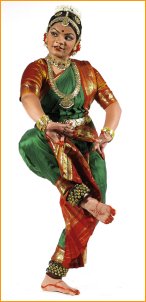 |
 |
MEERA EXCELS IN HER BHARATANATYAM
ARANGETRAM
October 2002 |
 |
| Chicago, IL
- A colourful rangoli and a tall brass lamp at its center greeted the audience
as they entered the Triton College Performing Arts Center in River Grove,
Illinois to witness the arangetram of Meera Mathew, disciple of Shoba Natarajan.
The invocatory ‘Gnana Sabesa Stotram’ flowed majestically from behind the closed curtains. Meera then began her recital with a Mallari in Gambhira Nattai and Eka Talam and followed it up with the first verse of the Ganesha Pancharatnam. A padam in Malayalam addressed to Lord Jesus set to a haunting Poorvikalyani followed as the second piece. Meera’s moving depiction of the Mary Magdalene episode and the birth of Christ were well received by the audience. The main piece of the evening – the imposing varnam of Papanasam Sivan, ‘Swami Naan Undan Adimai’ in Natakurinji, followed next. Meera’s footwork was firm and precise. She executed the complex choreography of the rhythmic passages with confidence and grace. Shoba’s nattuvangam for the same was crisp and lyrical, and brought back memories of her illustrious guru, Shri. S. K. Rajaratnam. |
| Meera’s
abhinaya was unhurried and mature – moving from bhakti to sringara and
back as the episodes of Markandeya Charitram and the Ananda Tandava
were depicted, along with the heroine’s longing for the Lord. Continued
experience is bound to help her maintain the flow in the abhinaya, while
moving from one sequence to another.
The post intermission session began with a Ugabhoga followed by ‘Baro Krishnayya’ - a composition of Kanakadasa in Ragamalika. Meera’s depiction of Yashoda beckoning the child Krishna, taking his hand and walking along before scooping him up in her arms and exiting into the wings brought a smile to many a face in the audience. ‘Shri Ramachandra’ – a bhajan in Hindi by Tulsidas was presented next. Shoba Natarajan’s music composition for this piece in a Ragamalika as opposed to the standard Yaman breathed fresh life into it and was matched by Meera with her enthusiastic interpretations. The sequence of the various kings trying to lift Shiva’s bow to win Sita’s hand was depicted with tasteful and subtle humor. Meera then continued with a liting thillana in the raga Nalinakanti. The short ‘suddha nritta’ interlude amply demonstrated Meera’s control over rhythm. A mangalam in Kurinji marked the end of the recital. |
 |
| The orchestra
comprising of Shoba Natarajan on Vocal and Nattuvangam, Subhashini Krishnamurthy
on Vocal, Janardhan Rao on Mridangam, Jaishankar Balan on the violin and
Jaishree Prasad on the Veena was a truly remarkable one. They ably supported
the dancer creating the right mood at the right time – especially Subhashini’s
singing of the Ugabhoga in Hamsanandi and the highly effective variations
in ‘Baro Krishnayya.’
The performance was a testimony to Meera’s dedication and involvement and the meticulous training imparted by Shoba Natarajan. Meera was awarded a plaque and the title of ‘Nritya Koustubha’ by her Guru. With further training, there is no doubt that Meera will blossom into a consummate artist. On an aside, it should be mentioned that the program was devoid of the unnecessary frills that one tends to notice at arangetrams – especially in the United States. The emphasis was clearly on the dance and the music – a heartening trend indeed. |